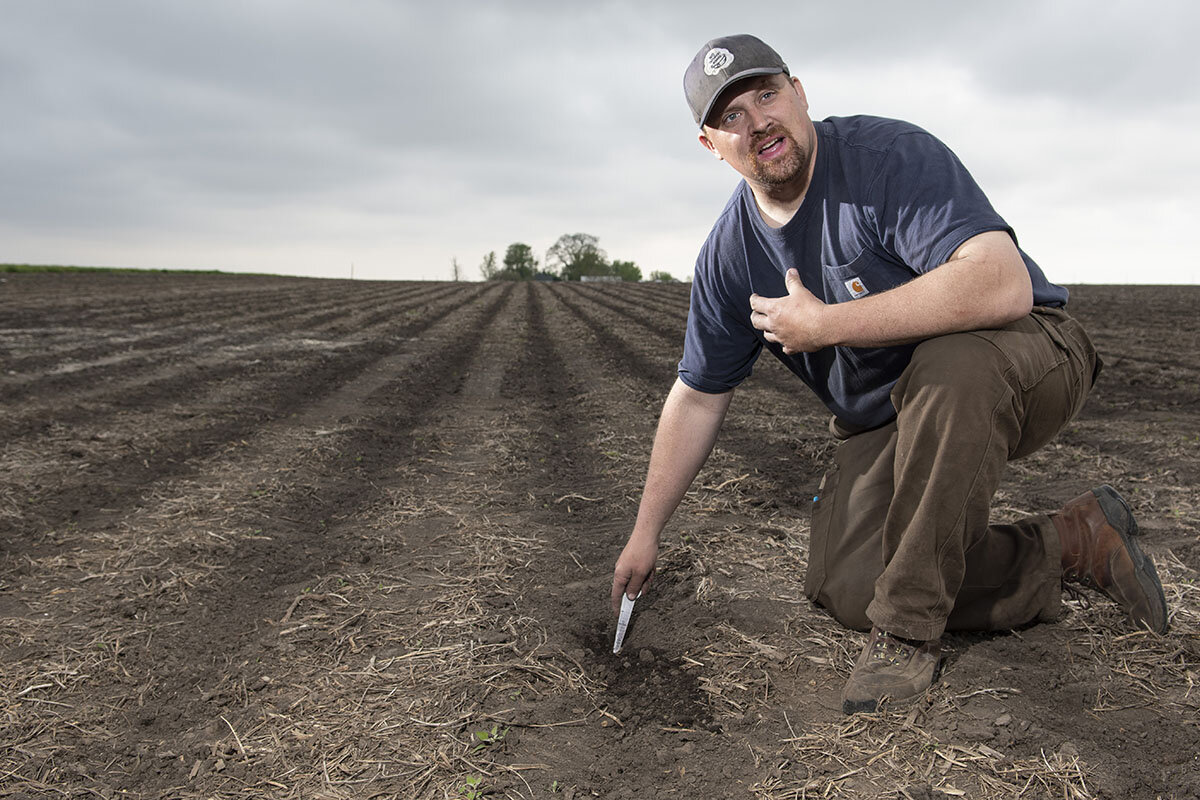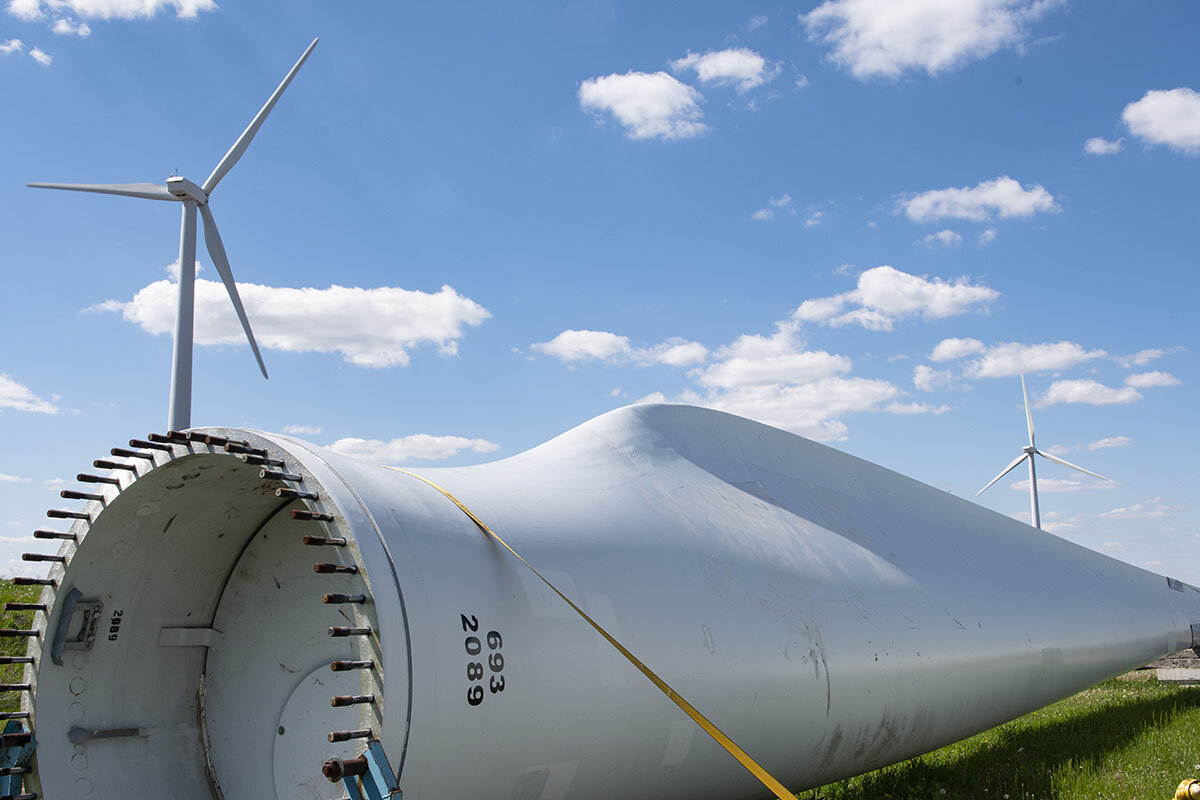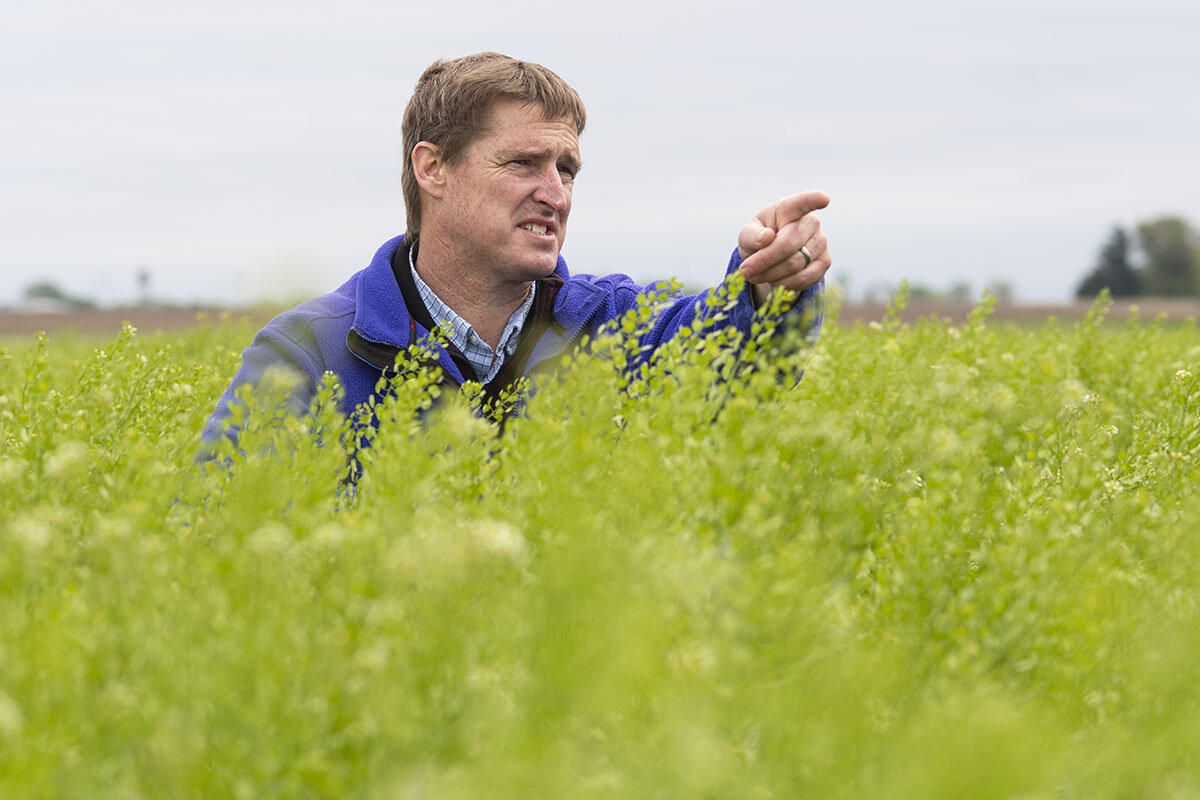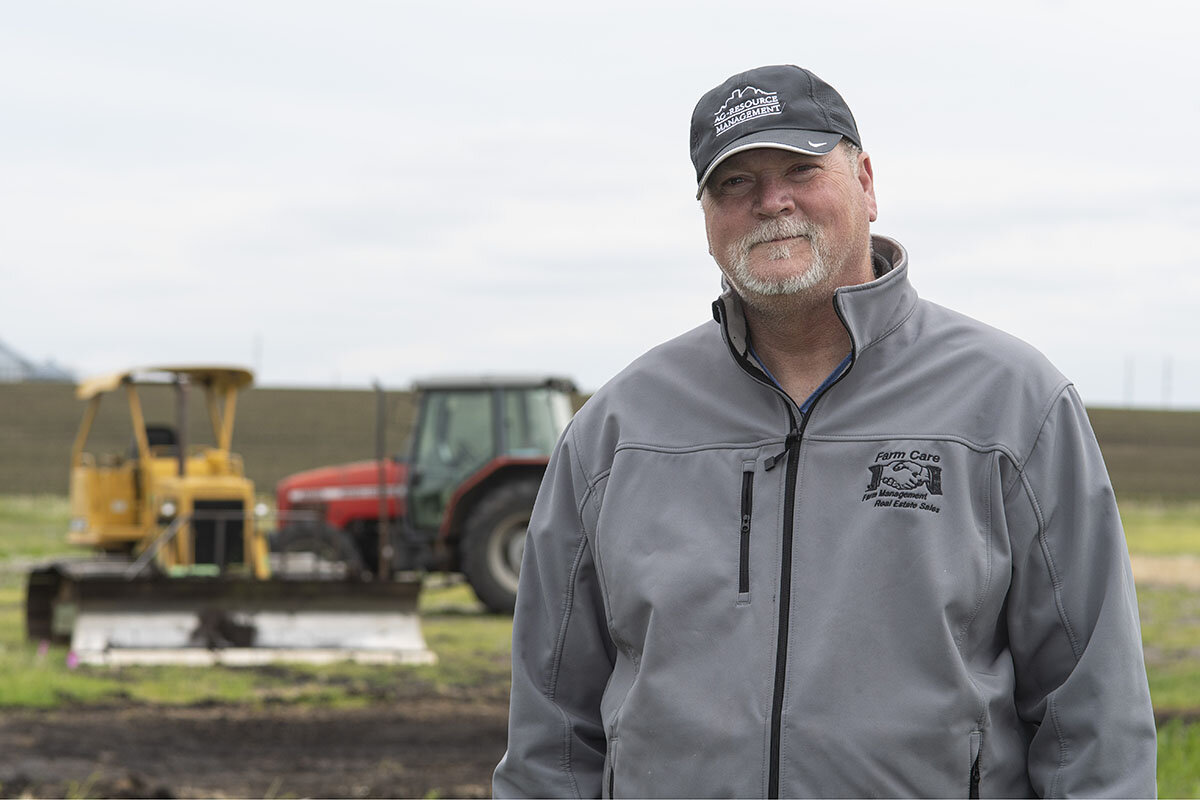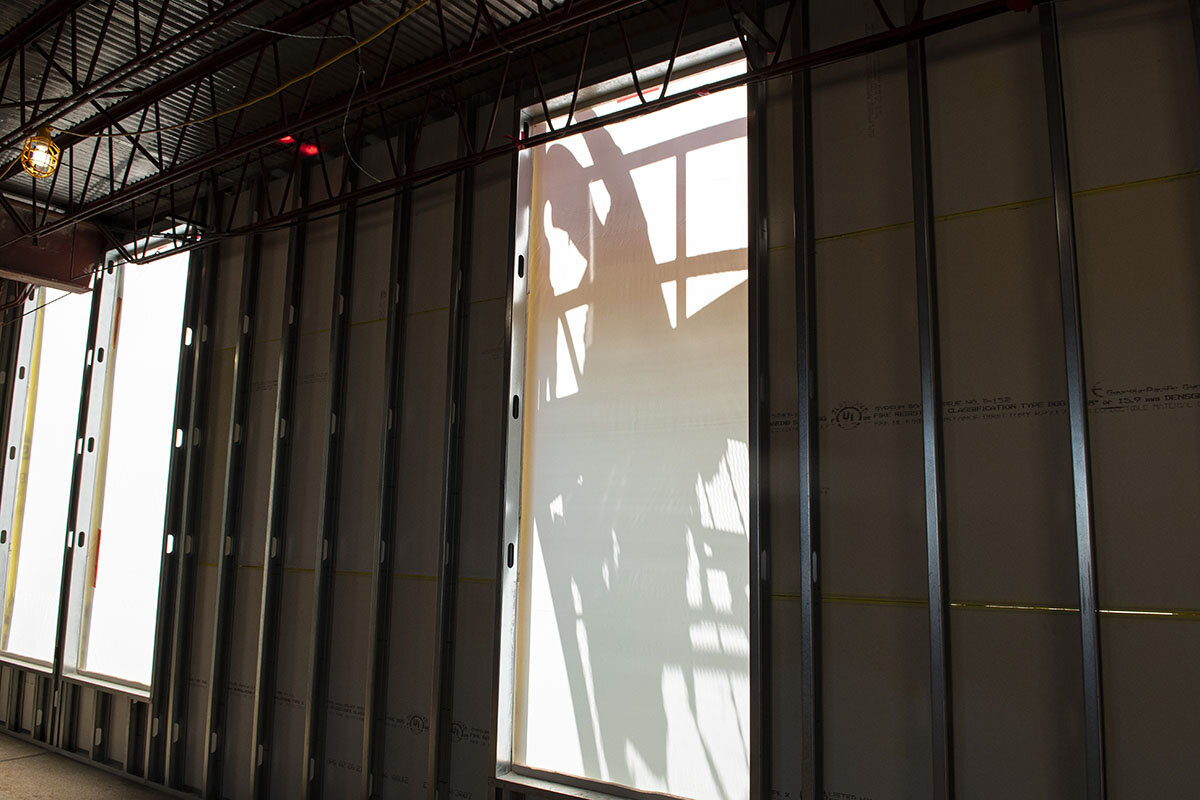Climate versus jobs? Not in this heartland state.
Loading...
| Oneida, Ill.
For five generations, Andrew Bowman’s family has worked the land in Oneida, population 700-ish – a flat and fertile swath of Illinois his father always said was good for growing crops and kids. Today, he farms soybeans and corn, as well as specialty popcorn, which he sells under the label Pilot Knob Comforts.
Mr. Bowman hopes to have a new resource to harvest soon, as well: wind.
This past year, Mr. Bowman took a lead representing local landowners in negotiating with Orion Renewable Energy Group, one of the many companies installing wind farms across Illinois, to build a new 100-turbine project in his part of Knox County. Clean energy would not only help keep the local school open and support the fire department and library, he says, but would also offer a new income stream to farmers who agree to lease some of their land for the project – some $30 million over 25 years, according to the proposal.
Why We Wrote This
Progress within the clean energy sector may be pushing the debate about climate change toward irrelevance. Across the Midwest – from wind farms to R&D labs – farmers are finding climate action is good business.
“It’s going to be life-changing for people who sign up,” Mr. Bowman says.
For Mr. Bowman, embracing wind power is part of stewarding the land for the next generation – and one of many steps he and his brother-in-law, Matt Hulsizer, have taken to ensure resiliency on their 1,800 acres. They are acutely focused on soil health, low tillage, and reducing fuel consumption; they have tried organic practices and are investigating cover crops to retain nutrients and prevent erosion.
But none of this is because they are trying to fight climate change.
They care deeply about the environment, they say; after all, they live and work in it. But they cringe at the cries for climate action, and they bristle when city people suggest their outdoor, low-consumption life is problematic. (“The difference between growing up on dirt and growing up on asphalt,” Mr. Hulsizer says.) If human-made climate change is happening, they say – something they find dubious – they doubt there’s much anyone can do to stop it.
For them, tending soil and harvesting wind for clean energy – two initiatives climate scholars say are crucial for reducing carbon emissions – is simply about taking the best steps economically.
And that, scholars point out, is a tremendous shift.
For years, the dominant narrative of climate action was one of trade-offs and costs – that saving the world as we know it meant taking hard steps to reduce carbon emissions, and likely sacrificing jobs and lifestyle in the process.
Over the past months, the Biden administration has worked to change this storyline, explicitly connecting “climate” with “good-paying union jobs,” and tying climate action to massive government investment and redevelopment. But travel across Illinois – a state that reflects the country’s political profile, with solidly red rural areas and a few blue cities – and one sees something more. Economic shifts, whether around clean energy or electric vehicles, regenerative agriculture or green construction, may be starting to defuse much of the debate over climate change.
Instead, climate action has merged with economic progress – particularly when it comes to clean energy. And although climate activists say this awakening won’t by itself put the nation on track to meet the Paris Agreement goal of net-zero carbon emissions by 2050, some suggest it is making that path less arduous, while creating new opportunities and connections for those across the ideological spectrum.
“There’s an argument that’s been around for a long time, that somehow the economy and the environment are at odds and we can’t do two things at once,” says Bob Keefe, executive director of E2, an organization of business groups focused on environmental action. “What we’re seeing today is that there’s never been more clarity about the economic costs of climate change, or the economic potential of climate action.”
Harvesting clean energy is climate action
The narrative of “climate versus jobs,” though, is an enduring one.
For decades, environmental protection has been presented in terms of extra costs such as regulations on businesses, requirements for companies, and restrictions on activities. While this wasn’t always divisive – the Clean Air Act of 1970 and the establishment of the Environmental Protection Agency were both highly bipartisan measures, for instance – it has increasingly become a dividing line between big-government Democrats and anti-regulation Republicans.
Where the left has seen necessary checks on industry for the preservation of the natural world, and the potential for a clean environment to lead to new economic prosperity, the right has seen challenges to businesses, job losses, and economic hardship. Both sides have studies that support their views.
Climate action has followed a similar pattern.
Although a bipartisan issue as recently as the 1980s (George H.W. Bush campaigned for president on climate action and criticized Democratic opponent Michael Dukakis for supporting coal), climate change has evolved into one of the country’s most politically divisive issues. For years, Democrats have reported caring about climate change far more than Republicans – and have also been more willing to sacrifice economically to prevent what they believe is a looming environmental catastrophe.
Until recently, few on either side of the aisle argued that addressing climate change would be a win-win for jobs and the environment.
But that, says an increasingly bipartisan collection of advocates, is exactly what it is.
“We’ve seen that constant conversation about jobs versus climate action,” says Catrina Rorke, vice president of policy for the Climate Leadership Council, a centrist bipartisan group that promotes policies to price carbon. “We think it’s woefully incorrect. We think aggressive climate action can actually unlock a lot of economic activity.”
In large part, says Stephen Cohen, former director of Columbia University’s Earth Institute, this is because a climate action economy is simply a modern economy – one that is moving away from a stagnating World War II-era industrial approach and into a newly automated, technologically innovative, and cleaner system.
“It’s 100 years later and it’s time to modernize,” he says. “We need to do these things for climate change reasons, but also the modern economy requires modernization. ... Most of the farsighted businesspeople – they know all of this. It’s how they think about the world.”
This isn’t just about fossil fuels versus clean energy, he and others say. From the auto industry’s shift to electric vehicles, with all of the connected grid and battery production, to the construction industry’s work retrofitting old buildings, to wind and solar energy jobs, the impact of climate-connected development is broad. It is also spurring a new wave of innovation and entrepreneurship, scholars say.
None of this means the end to the underlying political tension surrounding climate action: wariness on the right that government efforts to stabilize global temperatures will erode economic freedom, and concern among progressives that a focus on market-based solutions will distract from needed changes in consumption patterns and lifestyle.
Nor does this new economy benefit everyone. In any industrial shift, Dr. Cohen points out, some skills and jobs become obsolete. And when it comes to a climate-connected economy, those hardships are concentrated in particular communities, such as in West Virginia and Wyoming, that were built around fossil fuel extraction. In other words, it’s easy to focus on the story of a coal town dying because of a shift in the energy sector. The hardship is concentrated. It’s harder to tell a story when the benefits are diffuse, and everywhere.
“The losers are more specific and more easily identified – the winners might not exist yet,” says Wolfram Schlenker, a professor at Columbia University’s School of International and Public Affairs and the Earth Institute.
Still, Americans increasingly see a price to pay if rising temperatures go unchecked. The number of Americans who believe global warming will harm people in the United States a great or moderate amount grew from 51% in 2014 to 61% last year, according to polling by the Yale Program on Climate Change Communication.
Here in Illinois and elsewhere, most workers have jobs that aren’t directly focused on climate change. But “green” growth, from the booming renewables market to energy-efficient construction projects, is everywhere.
As a trip across the state shows, the positive economic story of industry that could be categorized as climate-related – even if those involved wouldn’t categorize it as such – is getting easier to observe.
Can a fungi protein patty beat the chicken nugget?
In a warehouse in the old Union Stockyards complex on the South Side of Chicago, the historic center of America’s meat production, lab-coated technicians last month harvested their first batch of Fy, a fungi protein grown from a small sample of microorganisms found in an acidic pool in Yellowstone National Park.
This tiny protein has unique properties that, with a bit of food science added in, can mimic the shape and texture of a variety of meat and dairy products, says Thomas Jonas, chief executive officer of Nature’s Fynd.
And his company has plans to do just that – in a big way.
Fy, Mr. Jonas says, could become the “most competitive protein in the world.” It is grown without sunlight, soil or rain; it ferments with simple sugars and other natural inputs, not too different from growing a sourdough yeast. It uses a fraction of the greenhouse gasses needed to create a chicken nugget, burger or yogurt. Nature Fynd’s first products, to be released later this year, will be a meatless patty and dairy-free cream cheese. Pre-orders quickly sold out.
For Mr. Jonas, Nature’s Fynd is all about climate action. Agriculture, he points out, is considered one of the top producers of greenhouse gases; the United Nations’ Food and Agriculture Organization has reported that meat and dairy production itself accounts for 14.5% of global greenhouse emissions. Creating an easy alternative to meat, one that both tastes good and is accessible to people throughout the world, could make a huge impact for environmental sustainability, he says.
“The reality is that for our generation there’s no bigger challenge than climate change,” Mr. Jonas says. “It will touch every single facet of every single part of our lives. ... We need to be part of a system where habits on a fundamental level are changed. That’s not to say you’re a bad person if you eat meat. There’s no villain here. The challenge here is about offering solutions that make the switch easy.”
Nature’s Fynd now employs 100 people between its Chicago manufacturing and production center and a research lab in Bozeman, Montana. Bill Gates’ climate venture capital group, Breakthrough Energy, has also invested heavily in the company – last year, it and Generation Investment Management LLP, a dedicated sustainable investment firm, mobilized $80 million of new funding.
That sort of capital influx is crucial for the type of innovation and development that not only helps fight climate change, but also spreads economic gain across a community, advocates say. This month, the Biden administration has made new commitments to up government research and development funding, as well as to smooth the way for new private investment. Both, advocates say, are vital.
Across the state, Western Illinois University agriculture professor Winthrop Phippen knows all about the importance of investment. For more than a decade, he has run a breeding program in Macomb, Illinois, focusing on pennycress, a plant with unique potential not only as a cover crop for farmers, but also as a source of sustainable jet fuel. In 2019, he won a $10 million federal grant to bolster his work.
The common name for pennycress is stinkweed, a moniker that both presents a bit of a public relations issue and belies some of the plant’s important qualities. Pennycress is, indeed, a common weed in the Midwest – and one that neither deer nor rabbits eat. But as a quick-growing plant, happy in this rich soil, pennycress not only attracts pollinators but also could be planted and harvested in between the corn and soybean rotation.
“Pennycress is really unique, in that it is one of the few oilseeds that have a really short growing season,” Dr. Phippen says.
Rather than the expanse of dirt that blankets Illinois in early spring, he says, fields of pennycress could be bringing in new income to farmers and supporting the effort to decarbonize the aviation industry. It would also help the soil sequester carbon, keeping it from entering the atmosphere – something Mark Rhea, owner of Agricultural Resource Management Inc., a company that helps manage farmland in the region, found particularly interesting.
Mr. Rhea was talking to Dr. Phippen about the possibilities of pennycress recently at the university’s outdoor breeding lab – 80-foot rows of waving, spring-green pennycress.
A for-profit company called CoverCress has partnered with Dr. Phippen and others to create a version of the plant with a seed husk more appealing to animals, to hopefully give farmers even more incentive to plant it. But just the carbon sequestration potential itself, Mr. Rhea says, is increasingly financially appealing to his clients. For years, he says, the carbon credit market has offered farmers only a few dollars an acre. Now, with the for-profit sector focusing on net-zero promises – pledges to reduce or offset its carbon emissions by the middle of the century – many expect that payment to go up to between $20 and $50 an acre.
“That starts to entice people,” he says. “Soil health – it’s becoming more of a catchword. In the past year or two, there are a lot more companies offering carbon credits if you’re doing certain practices.”
“Peace of mind” on the wind
This effort to reduce – or offset – carbon emissions has been fueling businesses across Illinois. One of the country’s 13 carbon capture plants is in Decatur, toward the south center of the state. An hour north, in the city of Normal, electric vehicle manufacturer Rivian has retrofitted an old Mitsubishi plant to produce its new electric adventure trucks. The company, which expects to employ 2,700 people at its plant by next year, sold out of the first version of its pickups within a week of allowing preorders. A report by the trade group Advanced Energy Economy earlier this year said that Illinois was poised to nearly double the number of electric transportation jobs by 2024, from an estimated 5,200 to more than 9,000.
And there is wind.
Drive across central Illinois and one can see how this is the fastest-growing wind energy state in the Midwest. Wind farms, with turbines towering over cornfields, have become big business here. Companies such as Orion Energy, which worked with Mr. Bowman, the Knox County farmer, have invested $13 billion in the state, according to Power Up Illinois, an advocacy group for clean energy. Wind and solar property taxes totaled $41.4 million in 2019 and now support 13,400 jobs in the state, the group says.
These companies also pay $41.8 million in annual lease payments to farmers.
“They’re a blessing, they really are,” says David Senn, a farmer in Tazewell County, southeast of Peoria, who now grows his crops around five turbines. “I can’t say enough about what the windmills are doing.”
Mr. Senn says that when the wind farm in his area was first proposed, some residents pushed back against it. But those criticisms have stopped, he says, now that people have seen not only the financial benefit to farmers, but also the tax revenue for roads and schools.
Indeed, northeast of Peoria in the city of Wenona, with a population of about 1,000, construction workers are starting a full, energy-efficient renovation of the middle school. Kari Rockwell, superintendent of the Fieldcrest Community School District, says the work was only possible because of new wind farm projects that are slated to add nearly $2 million to her budget in their first year.
“Our school district has decades’ worth of work that is very, very necessary on our buildings,” she says. “What we’ve seen is that the influx of money from wind farms gives local communities peace of mind in funding these projects.”
Indeed, perhaps more than in any other industry, progress within the clean energy sector may be pushing the debate about climate change toward irrelevance.
Tyler Duvelius, spokesman for the Conservative Energy Network advocacy group, says this is because more people simply see the economic opportunity in clean energy – as well as the possibility for U.S. energy independence. And clean energy is a booming employment opportunity, he says.
“There are 3.3. million clean energy jobs in America right now,” Mr. Duvelius says. “These jobs pay 25% more than the national median. One in 5 are in construction. There are plenty more in the clean energy supply chain. We’re looking at traditional, American jobs.”
But it’s not only jobs.
As Ken Springer, the economic development coordinator for Knox County, points out, many rural counties do not have the labor force to attract other industries. But because solar and wind farms do not need much labor once they are built, they can still locate in these areas, and still help the economy through lease payments and property taxes.
And according to a recent Brookings Institution report, most of the counties likely to benefit from clean energy lean Republican.
“Eighty percent plus of all clean energy projects are built in red, Republican districts,” says Jeff Danielson, central region director for the American Clean Power lobbying group. “That would not happen if they were not aware of and understood the economic value of those projects in their districts. ... So, as in all politics these days, you can find division. But scratch the surface a little deeper in clean energy and there is broad bipartisan support. Not everybody has the same reasons, and that’s important to acknowledge, but there is bipartisan support for clean energy.”
This is what Mr. Springer found during the effort to lure Orion Energy’s proposed wind farm – the one that Mr. Bowman, the farmer, helped negotiate.
Two years earlier, in 2018, Knox County had split over a proposed solar project.
“We had a legit protest,” Mr. Springer recalls.
So many people showed up to the zoning board meeting that they couldn’t fit in the room. People were holding signs that read, “no green energy in Knox County.”
But last year, Knox County commissioners voted 14-1 to approve Orion Energy’s proposed wind farm. Part of that, Mr. Springer says, is because of the work the company did to answer questions; part of it was that residents could see how wind energy has helped neighboring communities.
Mr. Bowman, for instance, is eager for his children’s school to get a desperately needed infusion of cash. Although the teachers and community there are wonderful, he says, the facilities are so bad right now that he worries about retaining staff.
“The wind turbines couldn’t come at a better time,” he says.






